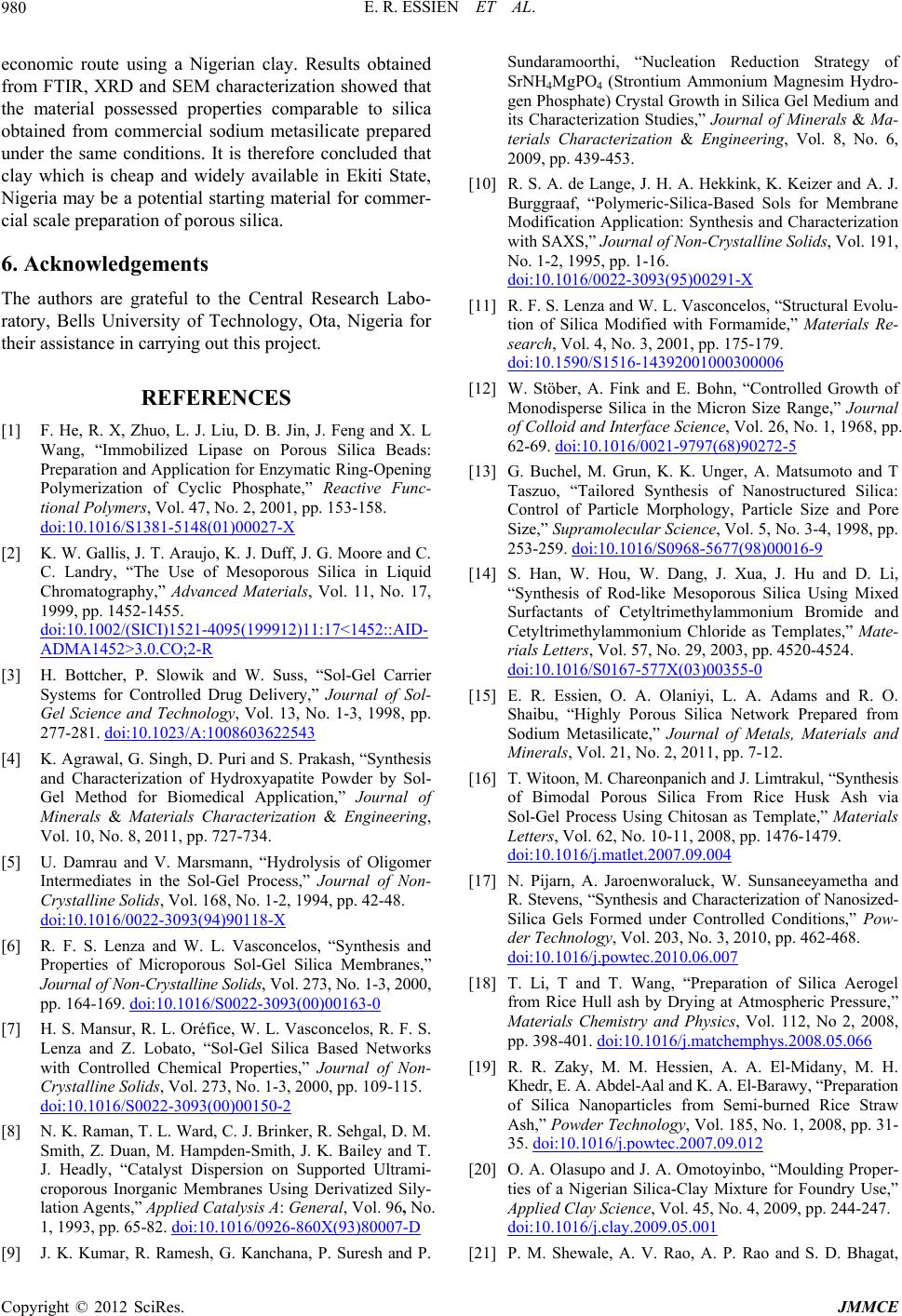
E. R. ESSIEN ET AL.
980
economic route using a Nigerian clay. Results obtained
from FTIR, XRD and SEM characterization showed that
the material possessed properties comparable to silica
obtained from commercial sodium metasilicate prepared
under the same conditions. It is therefore concluded that
clay which is cheap and widely available in Ekiti State,
Nigeria may be a potential starting material for commer-
cial scale preparation of porous silica.
6. Acknowledgements
The authors are grateful to the Central Research Labo-
ratory, Bells University of Technology, Ota, Nigeria for
their assistance in carrying out this project.
REFERENCES
[1] F. He, R. X, Zhuo, L. J. Liu, D. B. Jin, J. Feng and X. L
Wang, “Immobilized Lipase on Porous Silica Beads:
Preparation and Application for Enzymatic Ring-Opening
Polymerization of Cyclic Phosphate,” Reactive Func-
tional Polymers, Vol. 47, No. 2, 2001, pp. 153-158.
doi:10.1016/S1381-5148(01)00027-X
[2] K. W. Gallis, J. T. Araujo, K. J. Duff, J. G. Moore and C.
C. Landry, “The Use of Mesoporous Silica in Liquid
Chromatography,” Advanced Materials, Vol. 11, No. 17,
1999, pp. 1452-1455.
doi:10.1002/(SICI)1521-4095(199912)11:17<1452::AID-
ADMA1452>3.0.CO;2-R
[3] H. Bottcher, P. Slowik and W. Suss, “Sol-Gel Carrier
Systems for Controlled Drug Delivery,” Journal of Sol-
Gel Science and Technology, Vol. 13, No. 1-3, 1998, pp.
277-281. doi:10.1023/A:1008603622543
[4] K. Agrawal, G. Singh, D. Puri and S. Prakash, “Synthesis
and Characterization of Hydroxyapatite Powder by Sol-
Gel Method for Biomedical Application,” Journal of
Minerals & Materials Characterization & Engineering,
Vol. 10, No. 8, 2011, pp. 727-734.
[5] U. Damrau and V. Marsmann, “Hydrolysis of Oligomer
Intermediates in the Sol-Gel Process,” Journal of Non-
Crystalline Solids, Vol. 168, No. 1-2, 1994, pp. 42-48.
doi:10.1016/0022-3093(94)90118-X
[6] R. F. S. Lenza and W. L. Vasconcelos, “Synthesis and
Properties of Microporous Sol-Gel Silica Membranes,”
Journal of Non-Crystalline Solids, Vol. 273, No. 1-3, 2000,
pp. 164-169. doi:10.1016/S0022-3093(00)00163-0
[7] H. S. Mansur, R. L. Oréfice, W. L. Vasconcelos, R. F. S.
Lenza and Z. Lobato, “Sol-Gel Silica Based Networks
with Controlled Chemical Properties,” Journal of Non-
Crystalline Solids, Vol. 273, No. 1-3, 2000, pp. 109-115.
doi:10.1016/S0022-3093(00)00150-2
[8] N. K. Raman, T. L. Ward, C. J. Brinker, R. Sehgal, D. M.
Smith, Z. Duan, M. Hampden-Smith, J. K. Bailey and T.
J. Headly, “Catalyst Dispersion on Supported Ultrami-
croporous Inorganic Membranes Using Derivatized Sily-
lation Agents,” Applied Catalysis A: General, Vol. 96, No.
1, 1993, pp. 65-82. doi:10.1016/0926-860X(93)80007-D
[9] J. K. Kumar, R. Ramesh, G. Kanchana, P. Suresh and P.
Sundaramoorthi, “Nucleation Reduction Strategy of
SrNH4MgPO4 (Strontium Ammonium Magnesim Hydro-
gen Phosphate) Crystal Growth in Silica Gel Medium and
its Characterization Studies,” Journal of Minerals & Ma-
terials Characterization & Engineering, Vol. 8, No. 6,
2009, pp. 439-453.
[10] R. S. A. de Lange, J. H. A. Hekkink, K. Keizer and A. J.
Burggraaf, “Polymeric-Silica-Based Sols for Membrane
Modification Application: Synthesis and Characterization
with SAXS,” Journal of Non-Crystalline Solids, Vol. 191,
No. 1-2, 1995, pp. 1-16.
doi:10.1016/0022-3093(95)00291-X
[11] R. F. S. Lenza and W. L. Vasconcelos, “Structural Evolu-
tion of Silica Modified with Formamide,” Materials Re-
search, Vol. 4, No. 3, 2001, pp. 175-179.
doi:10.1590/S1516-14392001000300006
[12] W. Stöber, A. Fink and E. Bohn, “Controlled Growth of
Monodisperse Silica in the Micron Size Range,” Journal
of Colloid and Interface Science, Vol. 26, No. 1, 1968, pp.
62-69. doi:10.1016/0021-9797(68)90272-5
[13] G. Buchel, M. Grun, K. K. Unger, A. Matsumoto and T
Taszuo, “Tailored Synthesis of Nanostructured Silica:
Control of Particle Morphology, Particle Size and Pore
Size,” Supramolecular Science, Vol. 5, No. 3-4, 1998, pp.
253-259. doi:10.1016/S0968-5677(98)00016-9
[14] S. Han, W. Hou, W. Dang, J. Xua, J. Hu and D. Li,
“Synthesis of Rod-like Mesoporous Silica Using Mixed
Surfactants of Cetyltrimethylammonium Bromide and
Cetyltrimethylammonium Chloride as Templates,” Mate-
rials Letters, Vol. 57, No. 29, 2003, pp. 4520-4524.
doi:10.1016/S0167-577X(03)00355-0
[15] E. R. Essien, O. A. Olaniyi, L. A. Adams and R. O.
Shaibu, “Highly Porous Silica Network Prepared from
Sodium Metasilicate,” Journal of Metals, Materials and
Minerals, Vol. 21, No. 2, 2011, pp. 7-12.
[16] T. Witoon, M. Chareonpanich and J. Limtrakul, “Synthesis
of Bimodal Porous Silica From Rice Husk Ash via
Sol-Gel Process Using Chitosan as Template,” Materials
Letters, Vol. 62, No. 10-11, 2008, pp. 1476-1479.
doi:10.1016/j.matlet.2007.09.004
[17] N. Pijarn, A. Jaroenworaluck, W. Sunsaneeyametha and
R. Stevens, “Synthesis and Characterization of Nanosized-
Silica Gels Formed under Controlled Conditions,” Pow-
der Technology, Vol. 203, No. 3, 2010, pp. 462-468.
doi:10.1016/j.powtec.2010.06.007
[18] T. Li, T and T. Wang, “Preparation of Silica Aerogel
from Rice Hull ash by Drying at Atmospheric Pressure,”
Materials Chemistry and Physics, Vol. 112, No 2, 2008,
pp. 398-401. doi:10.1016/j.matchemphys.2008.05.066
[19] R. R. Zaky, M. M. Hessien, A. A. El-Midany, M. H.
Khedr, E. A. Abdel-Aal and K. A. El-Barawy, “Preparation
of Silica Nanoparticles from Semi-burned Rice Straw
Ash,” Powder Technology, Vol. 185, No. 1, 2008, pp. 31-
35. doi:10.1016/j.powtec.2007.09.012
[20] O. A. Olasupo and J. A. Omotoyinbo, “Moulding Proper-
ties of a Nigerian Silica-Clay Mixture for Foundry Use,”
Applied Clay Science, Vol. 45, No. 4, 2009, pp. 244-247.
doi:10.1016/j.clay.2009.05.001
[21] P. M. Shewale, A. V. Rao, A. P. Rao and S. D. Bhagat,
Copyright © 2012 SciRes. JMMCE